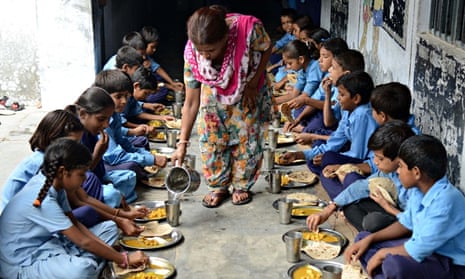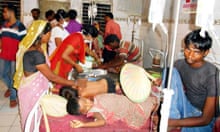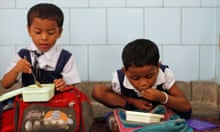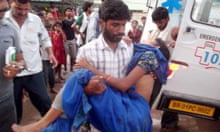The dirt roads leading to the village of Karulihai in the Indian state of Madhya Pradesh make for a bumpy ride. As clouds of dust settle on the windscreen, it’s easy to miss the one-room school that stands in the middle of the field. Voices of children, reciting multiplication tables, float out. Hearing our car, the teacher, Mr Sonpal, peers out. “Are you from the block office,” he asks anxiously. “Have you brought the provisions for the meals?”
The school, in a remote, poor area, is entitled to free lunches that are served in every government-run school in India.
But no lunch has been served here since November 2013.
For most of the children living in this area, whose parents earn less than £3 a week doing manual labour or subsistence farming, the free lunch is often their only meal of the day. Mr Sonpal is the only teacher in this school of 15 students, but lack of staff is the least of his worries.
India’s midday meal scheme is the largest school feeding programme of its kind in the world and counts former US president Bill Clinton among its admirers.
The scheme was set up in 1995 to ensure hunger didn’t prevent children from attending school and nearly 120 million children are fed daily. But the programme is rife with corruption and improperly implemented, which frequently endangers and lets down the vulnerable population it seeks to serve.
Last month was the first anniversary of the school meal poisoning incident in Bihar that killed 23 children. But, one year on, the safety of meals is still a concern.
This month, the Times of India reported that 50 students of a government primary school had to be hospitalised in Bihar after eating a meal contaminated with a dead lizard. In May, children in Delhi fell sick after eating food containing worms. The situation is worse in remote hamlets, where children are most in need of a nutritious meal.
Janmavati Saket, a teacher in Jawa village, in Madhya Pradesh’s Rewa state, says: “Earlier the children would make a lot of noise. But ever since the lunches stopped they are quieter. A few have even stopped coming [to school].”
Saket’s school hasn’t been given funds for the food for the past six months. “I keep going to the collector [the officer in charge of the district] but he shunts me off to the block officer [local official] saying he has to sanction the money,” she says. “It has been months and I have 20 hungry children to feed.”
In 2013-14, nearly Rs 30bn (£290m) was allotted by the Indian government to the scheme. “The education ministry handles the programme and nearly one-third of the education budget is allocated to this,” says Govindraj Ethiraj, the founder of IndiaSpend, a data-driven journalism initiative. “Should the education ministry be handling this or should the health ministry take over since it is about nutrition? People who should be managing schools are running the feeding programme and maybe that’s why there are so many distortions. An administrative separation of duties might help make this more efficient.”
Yamini Aiyar, director of the Accountability Initiative, part of the Center for Policy Research in New Delhi, says: “There is no getting away from creating a more efficient administrative structure.” Aiyar’s investigation into the scheme found that too many layers of government were involved in the scheme, resulting in poor information, coordination and monitoring.
The state government partners NGOs to improve distribution of meals. The Akshaya Patra Foundation, one such NGO, works through centralised kitchens in which meals are cooked and sent out to schools. In areas where centralised kitchens can’t be set up, it employs local women’s groups. “We bring stringent quality control that ensures food cooked in hygienic surroundings is delivered safely to schools,” says Bharathi Ghanashyam, a director of Akshaya Patra.
However, regulations don’t allow NGOs to serve food in rural areas, and there are inherent challenges in operating centralised kitchens in remote areas, says Binali Suhandani, country director for resource mobilisation at Akshaya Patra. “Given poor roads and transport conditions in these areas, the delivery of fresh food becomes a problem. On the other hand, in decentralised kitchens applying quality checks can be tough. Training those who work in the kitchens is important and it’s here that the biggest lapses happen.”
Research has shown that the scheme has boosted school attendance of girls (pdf) and improved nutrition (pdf) among children, especially in poor areas. After the Bihar tragedy, Akshaya Patra trained more than 200 cooks and supervisors in safe cooking techniques. “But this is very marginal when you see the number of kitchens and children that need feeding,” says Suhandani. “There has to be a replicating effect of this training. What we need is an emphasis on responsible handling of food, greater accountability and the creation of a structure that ensures that no school is left behind.”





Comments (…)
Sign in or create your Guardian account to join the discussion